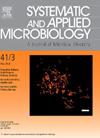嗜碱嗜碱嗜碱菌,嗜碱嗜碱菌,嗜碱嗜碱菌,嗜碱嗜碱菌,嗜碱嗜碱菌,嗜碱嗜碱菌,嗜碱嗜碱菌,嗜碱嗜碱菌,嗜碱嗜碱菌,嗜碱嗜碱菌,嗜碱嗜碱菌,嗜碱嗜碱菌,嗜碱嗜碱菌
IF 4.2
2区 生物学
Q2 BIOTECHNOLOGY & APPLIED MICROBIOLOGY
引用次数: 0
摘要
在西伯利亚西南部的碱湖中,用三种形式的不溶性纤维素在中等盐度下进行有氧富集,选择了一个由初级纤维素营养拟杆菌及其γ -变形菌半纤维素降解伙伴组成的二元联合体。拟杆菌门菌株ABcell3T在纯培养中从软琼脂中无定形纤维素形成的菌落中分离出来,而γ -变形杆菌卫星菌株ABcell2T则用葡甘露聚糖代替纤维素选择性纯化。ABcell3T在胞噬科(Cytophagaceae)中被鉴定为一个新属谱系,ABcell2T在海洋微生物属(Cellvibrionaceae)中被鉴定为一个新种。ABcell3T的特点是复杂的细胞形态发生,年轻的细胞是具有滑动运动的柔韧的长杆,变成囊肿样的屈光圆。它是一种高度特化的纤维素营养菌,与各种形式的天然纤维素一起生长最好,对木葡聚糖和纤维素二糖的活性较低。ABcell2T是一种活动弧菌形成的黄色色素。它具有广泛的水解潜力,与各种葡聚糖(但不包括纤维素)和糖一起生长。通过在纤维素上成功地重建二元联合体,证实了它作为糖解清除剂的功能。这两种细菌都是需氧、中等耐盐的嗜碱菌,在总Na+为0.4-0.8 M、pH为9.0-9.5的碳酸盐环境下生长最佳。ABcell3T菌株的功能基因组分析鉴定出14个潜在纤维素酶基因拷贝,分别来自GH家族5_1/5_2、9和8。ABcell2T的基因组也包含四个GH9纤维素酶基因,但其他基因都不包含。相反,存在不同GH5亚家族的多个拷贝,具有潜在的半纤维素底物特异性。根据表型特征和系统基因组分析结果,提出菌株ABcell3T为新属新种Natronocytophaga cellulosiphila (DSM 115919 = UQM 41578),菌株ABcell2T -为新属新种Marinimicrobium hydrolyticum sp. nov. (DSM 115774 = JCM 35976)。本文章由计算机程序翻译,如有差异,请以英文原文为准。
Natronocytophaga cellulosiphila, gen. nov., sp. nov., and Marinimicrobium hydrolyticum sp. nov., aerobic haloalkaliphilic bacteria of a cellulose-mineralizing consortium from soda lakes
Aerobic enrichments with three forms of insoluble cellulose at moderate salinity from soda lakes in southwestern Siberia selected a binary consortium consisting of a primary cellulolotrophic bacteroidetes and its gammaproteobacterial hemicellulolytic partner. The bacteroidetes strain ABcell3T was separated in pure culture from colonies formed in soft agar with amorphous cellulose, while the gammaproteobacterial satellite, strain ABcell2T, was selectively purified using glucomannan instead of cellulose. ABcell3T was identified as a new-genus lineage in the family Cytophagaceae, and ABcell2T formed a new species within the genus Marinimicrobium (family Cellvibrionaceae). ABcell3T is characterized by a complex cell morphogenesis with young cells as long flexible rods with gliding motility turning into cyst-like refractive circles. It is a highly-specialized cellulotroph, growing best with various forms of native celluloses and less actively on xyloglucan and cellobiose. ABcell2T is a motile vibrio forming yellow pigment. It has a broad-range hydrolytic potential, growing with various glucans (but not cellulose) and sugars. Its function as a saccharolytic scavenger was confirmed by a successful reconstitution of the binary consortium on cellulose. Both bacteria are aerobic, moderately salt-tolerant alkaliphiles, growing optimally at 0.4–0.8 M total Na+ as carbonates and pH 9.0–9.5. Functional genome analysis of strain ABcell3T identified fourteen gene copies for potential cellulases from the GH families 5_1/5_2, 9 and 8. The genome of ABcell2T also contains four GH9 cellulase genes but none of the others. Instead, multiple copies of different GH5 subfamilies were present with a potential hemicellulose substrate specificity. Based on phenotypic characteristics and results of phylogenomic analysis, strain ABcell3T is proposed as a new genus and species Natronocytophaga cellulosiphila (DSM 115919 = UQM 41578), and strain ABcell2T – as Marinimicrobium hydrolyticum sp. nov. (DSM 115774 = JCM 35976).
求助全文
通过发布文献求助,成功后即可免费获取论文全文。
去求助
来源期刊

Systematic and applied microbiology
生物-生物工程与应用微生物
CiteScore
7.50
自引率
5.90%
发文量
57
审稿时长
22 days
期刊介绍:
Systematic and Applied Microbiology deals with various aspects of microbial diversity and systematics of prokaryotes. It focuses on Bacteria and Archaea; eukaryotic microorganisms will only be considered in rare cases. The journal perceives a broad understanding of microbial diversity and encourages the submission of manuscripts from the following branches of microbiology:
 求助内容:
求助内容: 应助结果提醒方式:
应助结果提醒方式:


